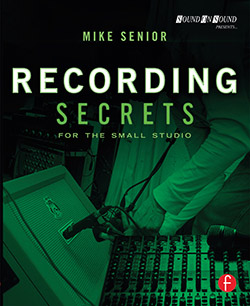Recording Secrets For The Small Studio - Additional Resources (1st Edition Archive)
Chapter 3: Instruments With Pickups
Table of Contents
(This page contains archived resources for the first edition of Recording Secrets For The Small Studio. You can access updated resource pages for the current edition here.)
Audio Files
(To download all WAV examples at once: 3MB ZIP)
String Instrument Fingering Positions: On an orchestral stringed instrument, the same pitches can frequently be played on different strings to achieve a very characteristic tonal variation. For example, listen to this small melodic line played on three different strings of a viola: the ‘A’ string Ex03.01: WAV/MP3play_arrow; the ‘D’ string, tuned a 5th lower Ex03.02: WAV/MP3play_arrow, and the ‘G’ string, tuned a 9th lower Ex03.03: WAV/MP3play_arrow.
Guitar Fret Buzz: If a guitar’s action (the height of the strings above the fretboard) isn’t set appropriately, then it can result in ‘fret buzz’, where the strings rattle against the frets during performance – as heard in this audio example Ex03.04: WAV/MP3play_arrow.
Links
Handy Communications Gadgets: Here are a couple of affordable little mic switching boxes that both work well: Radial’s passive HotShot DM1, designed to work with dynamic mics only, and the active Mic Mute Lite from Orchid Electronics, which requires phantom power to run, but which can also be used in conjunction with phantom-powered mics. Orchid Electronics were also responsible for the custom-built dual Mic Mute unit pictured on page 89 of Recording Secrets For The Small Studio.
Automatic Software Talkback/Listen-mic Switching: Although I prefer (as discussed in the book) to have hardware switching for talkback and listen mics, and to operate them manually, if you don’t have a problem with automatic software switching then check out Sound Radix’s cute little freeware Muteomatic

 plug-in that can do automatic muting/unmuting in response to your DAW’s transport status.
plug-in that can do automatic muting/unmuting in response to your DAW’s transport status.
Further Reading
Some Real-world Small-studio Communications Systems: In section 3.2.3 of the book, I discuss general principles of small-studio communications using talkback and listen mics. To supplement this, here’s a PDF document with concrete examples of small-studio communications systems , including some discussion of each setup’s pros and cons.
Further Audio Editing Advice: Try this two-part series from Sound On Sound magazine, which has lots of information about real-world audio-editing procedures within the computer DAW environment: Part 1 & Part 2. The subject is also dealt with in depth in Chapters 6 & 7 of my other book, Mixing Secrets For The Small Studio.
Warwick Kemp’s Track Expansion Method: If you’re working within a limited trackcount without transport-synchronisation facilities (perhaps because you prefer using an analogue recorder), you can still generate slave reels using Warwick Kemp’s Track Expansion Method, and ingenious scheme which takes advantage of the human sensitivity to interaural time-delays.
Working With Latency In Computer Systems: See the Chapter 2 resources page.
Further Information About Instrument Setup/Maintenance: The Guitar Repair Bench site has lots of user-friendly entry-level tutorials on setting up and maintaining electric guitars, and there are lots of great in-depth resources on the net for users of electromechanical keyboards too: The Rhodes Super Site, the Wurlitzer Electric Piano List, and the Hohner Clavinet & Pianet Resource Homepage. If you’re working with analogue synths, then the Synthesizers.com Links page is a great springboard for finding out anything you need to know. Violin-maker Russell Hopper has decent basic advice about handling and care of orchestral string instruments, and there are also some nice supporting video presentations from Russell Hopper on the same subject.
Pre-production & Arrangement Tips: If you’re looking for ideas here, there are plenty of workshops in Sound On Sound magazine’s archives: ‘Pre-production: Producers Share Their Wisdom’, ‘A Rough Guide To Song Construction & Arrangement’ (part 1; part 2; part 3; part 4); ‘Great String Parts On A Budget’; ‘Arranging For Strings’ (part 1; part 2; part 3; part 4); ‘Arranging For Brass’ (part 1; part 2; part 3; part 4); and ‘Working With Orchestrators & Arrangers’.

